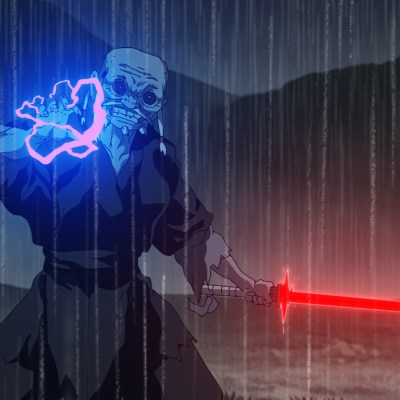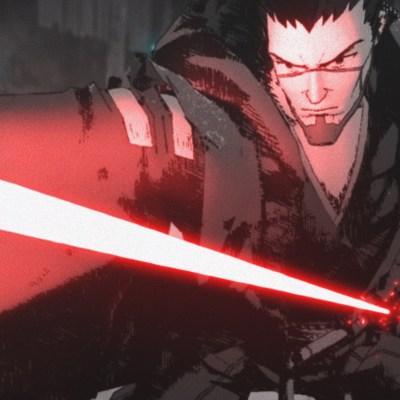What Star Wars: Visions Has in Common With Hayao Miyazaki and Studio Ghibli
Star Wars: Visions explores the environmental side of the saga's settings like no Star Wars movie or TV series before it.

The beauty of the natural world and its spiritual elements have long been popular subjects for anime, and in the new short film anthology Star Wars: Visions that translates to rich forests and bringing life to once barren ground. With its emphasis on how characters affect the environments around them, Visions touches on both the history of anime and an idea that has been present but muted in most Star Wars stories: that the evil of the Empire goes hand-in-hand with resource exploitation and greed.
Naturally, anime is an art style — developed in Japan and with a wide range of inspirations behind it — not a single genre. You can find anime films and TV shows espousing and glorifying a wide range of philosophies, from the green of the trees to the virtues of guns. But some of the most successful examples have included the former.
Hayao Miyazaki and Studio Ghibli, the director and studio behind perhaps the most well-known anime films in the west, make the association between the style and environmental messages clear. Princess Mononoke directly depicts a fight between the denizens of the forest and the humans who have been clearcutting it. My Neighbor Totoro romanticizes a countryside and forest filled with Shinto-inspired creatures as well as real-world shrines and practices. Other popular anime, like the Moribito series (based on the novels of the same name) or Mushishi, also focus on nature as a source of spirituality, if not always safety.
Star Wars, itself inspired in part by Japanese films, addresses this indirectly but thoroughly. While the heroes tend to be visually associated with earth tones, sacred places, and magical trees, the villains wear metal and stark colors. The heroes are the underdogs, after all: the villains have the technological upper hand, even if a well-placed missile can destroy a whole battle station.
This is especially obvious in Return of the Jedi, which un-subtly pits the ultra-sterile trappings of the Empire against the raucous Ewoks. While the Empire destroys planets, the Ewoks live in trees and forage from the land. In The Clone Wars, destroying the environment is associated with disaster, like when the Separatists turn their Defoliator on their enemies’ planets or when a mixed Republic and Dug project disturbs the Zillo Beast from its underground lair. The Mandalorian makes this clear in the season two episode “The Jedi,” itself heavily inspired by Japanese director Akira Kurosawa; the Empire’s presence seems to be draining the planet, leaving churned-up mud and dying trees around the town.
The Visions episode that does the most with this theme is “The Village Bride,” which presents a planet where people have a home-grown understanding of the Force. “Magina,” or the Force, is connected directly to the planet: “You can’t change the river’s flow by casting a stone, but live in harmony with nature, and you’ll change together,” one Jedi says. The visuals focus on the forest, on how it can be both beautiful and inhospitable to humans. “We are the sky, we are the forest, we are the river,” goes the chant the titular bride and groom perform.
The actual destruction of the world is mostly hidden — an explosion here, a flashback there. Unlike many of the other shorts in the series, the villains are not even reminiscent of the Empire. Instead, they’re bandits using reprogrammed Separatist droids.
Perhaps the most subtle expression of this theme in the episode is the opening scene, where the wanderer Valco activates what appears to be a lightsaber, then proves to be a sensor of some kind. While he’s capable of fighting, he’s also fighting in his own way with research and science.
“T0-B1” also shows that being a hero can mean tending the planet, not necessarily swinging a lightsaber — although the hero certainly does also swing a lightsaber. Inspired by his mentor’s death, the little droid T0-B1 tries to grow plants on the inhospitable desert world. (T0-B1 is a visual echo of Astro Boy, the hero from the 1952 manga, which was later adapted into one of the most successful and familiar anime franchises of all time.) The science is presented as wondrous and soft, and learning how to make the planet green again is the triumph that leads him to gain his lightsaber and become a Jedi Knight.
Of course, the episode also presents him with a convenient villain — he needs to have a martial victory as well as a life-bringing one. Getting to what Yoda said — war not making a person great — is still not quite possible on screen in a franchise built in part on the spectacle of lightsaber battles. But “bringing life back to this planet” is T0-B1’s mission, and his resolution at the end of the episode is that “helping planets…that’s what Jedi do.”
“The Ninth Jedi” evokes some of the industrialization presented as the enemy in other episodes, but doesn’t do as much with it. Throughout the series, we see that kyber crystals, the power source of a lightsaber, are nearly as prized, valuable, and flashy as the laser swords themselves. The process of mining kyber from asteroids in “The Ninth Jedi” is visually arresting, with cords shot into space from machines resembling oil rigs and dragged down to the planet in violent crashes.
The episode doesn’t have much to say about this: the kyber crystals are as noble in good hands as they are sinister in evil ones, with lightsaber colors switching to match each person’s ethical standing. Even so, it’s a cool look at one way to get ahold of this essential piece of Star Wars technology.
One of the best episodes in the series, “Lop and Ochō,” also works the pro-environment theme, both visually and in dialogue. It presents a marked contrast between the industrial Imperial base and the verdant planet around it. Even the hero Lop, a bunny-like alien, is more animalistic than the people around her. But the real insight in this episode comes from the story of why her adopted sister Ochō decides to join the Empire. She explains in a straightforward manner that she’s doing it to help her family: the “Imperial industry” that has “stripped and exploited” the planet will bring “growth and prosperity,” she says.
Ochō’s arguments for how the benefits of the alliance will help the family — money, presumably, and an ever-increasing flow of it — make sense. That’s what’s so honest (and frightening) about them. She wants the same thing Lop does — to keep the family safe — but wants to go about it in a different way. To her — and to the Imperial officer who has been conspiring with her — the family’s “idealism” is just getting in the way. “How are feelings supposed to save our family?” Ochō asks.
I won’t spoil the ending of this one, so suffice it to say the sisters’ clashing opinions are both tested. By the end of the episode, the visuals show primarily the stark metal of the Imperial base, with decorative trees reminding the viewer that the natural world is also part of the conversation. By combining the visual tropes of Star Wars and anime, Visions creates a strong message from both.
Star Wars: Visions executive producer James Waugh and producer Kanako Shirasaki spoke to Den of Geek about this connection in an interview, saying the “unique cultural perspective” lends itself to this theme.
“It comes down to the point of the anthology really, which was a unique cultural perspective and a unique art form expressing Star Wars,” Waugh says. “So much of that type of storytelling [about nature] feels so at home with anime because it permeates a lot of the fiction that comes out of Japanese culture in general.”
But the focus on the environments of Star Wars came naturally, according to Waugh. It wasn’t a mandate.
“There was never a conscious moment where we said we were really leaning into the idea of should we do these stories or not. It was these creators had a vision, each one had a point of view and a story they wanted to tell, and those were the themes they were gravitating towards. And that resonated with Star Wars in the sense that they were powerful, resonant themes that felt a little mythic, and then it was really a matter of getting characters rendered in a way that they had to react to the situation and we had to care for them. But it was totally the byproduct of working with creators who have a very specific point of view and something to say.”
Shirasaki adds, “The creators are heavily influenced from Star Wars at the same time as the rich history of Japanese animation, and Miyazaki and other Japanese storytelling talking about nature and development and all the conflict between these two. So maybe these topics might feel closer to them to tell, and also in a Star Wars setting.”
Miyazaki is often quoted as one of the medium’s most powerful voices on environmentalism. In a 2009 interview, the legendary animator said that this idea needs to go beyond storytelling as well: “Whether we should do something about it or not is something that we need to think about in real life, rather than depicting it in a particular way in the stories on screen.”
Star Wars: Visions is streaming now on Disney+.


